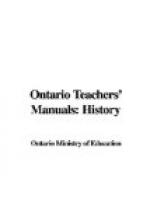3. The following were the chief causes of the movement:
(a) The Crusades
(b) The Fall of Constantinople, 1453
(c) The introduction of the mariner’s compass
(d) The invention of gunpowder
(e) The invention of the printing press
(f) The overthrow of the feudal system
(g) The desire for knowledge stimulated by the universities
(h) The failure of the schools of the Middle Ages to meet the demands and needs of the times
4. The relation of each of these causes to the New Learning must be shown. In dealing with the Crusade movement as a cause, it will be necessary to help the children to see the effect produced on the people of northern Europe by their coming into contact with the more highly cultivated people in southern Europe; and the effect produced on the people of Europe by their mingling with the nations of the luxurious East—the Greeks of Constantinople and the brilliant Mohammedan scholars of Palestine. The Crusades made the people dissatisfied with the conditions that had prevailed so long in Europe, and this fact alone gave an impetus to the New Learning.
The relation of printing to the spread of the movement is evident. The introduction of printing meant the cheapening of books, their more general use, and the spread of education. This was followed by a growing independence of thought, and a desire for greater political and religious freedom.
The other causes may be similarly treated.
5. The New Learning was represented in England by a group of scholars of whom Erasmus, Colet, and More were the chief. The great churchmen, too, were its patrons. Men of every rank were interested, and the movement affected the whole life of the people. A new interest was taken in education, in art, in religion, and in social reform. Old methods of instruction were superseded by more rational ones. Hundreds of new schools were established for the benefit of the middle classes. The whole tendency of the New Learning was toward a higher intellectual and more moral life.
6. Its effects:
(a) It awakened a desire for an intellectual life and for social reform;
(b) It made possible the Reformation;
(c) It led to the establishment of schools and libraries and to the extension of the usefulness of the universities;
(d) It aroused the desire for liberty and the spirit of enterprise, and encouraged commercial activity;
(e) It inspired some of the world’s greatest artists in painting, sculpture, architecture, literature, and music.
(f) It implanted the seeds of freedom of thought and fostered the spirit of scientific research;
(g) It supplied higher ideals of life and conduct, a fact which became responsible to a large extent for the great improvement made in the condition of the people, and in the development of Europe since that time.




